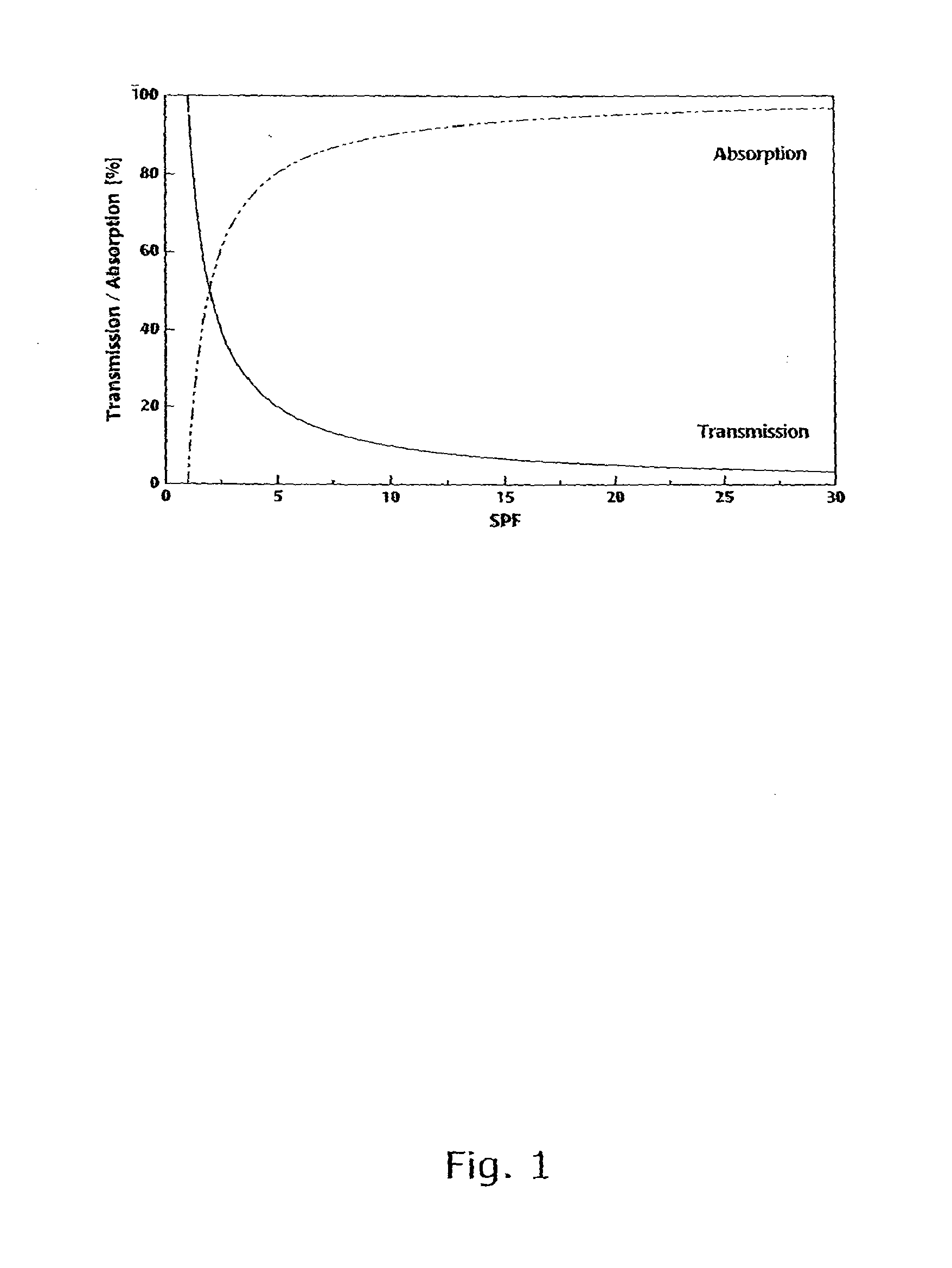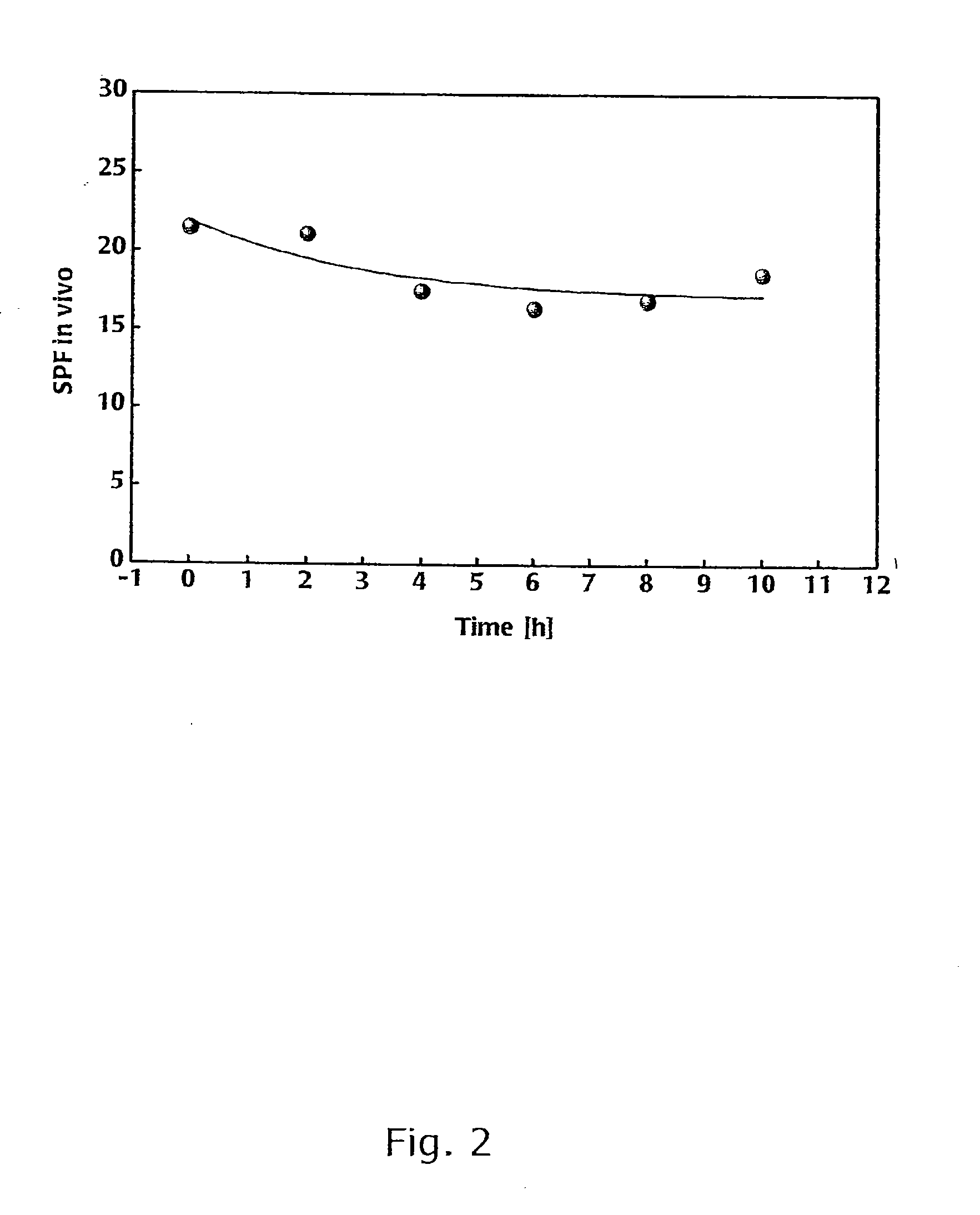Emulsion
a technology of emulsion and emulsion, which is applied in the direction of biocide, plant growth regulator, pharmaceutical non-active ingredients, etc., can solve the problems of skin burns, skin elasticity loss, and appearance of wrinkles
- Summary
- Abstract
- Description
- Claims
- Application Information
AI Technical Summary
Benefits of technology
Problems solved by technology
Method used
Image
Examples
example 1
Preparation of an Emulsion-Type Product Comprising UVA and UVB Filters
Ingredients
[0164]
MængdeStepsIngredientsw / w %2.1Alcohol denat. (solvent)56-582.,3Aqua (Solvent)4.0-5.02.2Hydroxypropylcellolose (Emulsion stabilizer / film0.3-0.5former / thickening agent, a hydrophilic colloid)1.4Acrylates / Octylacrylamide Copolymer (Film former, a1.8-2.2synthetic polymer)1.2PPG-15 Stearyl Ether (Emolient / weak emulisifier, an4.5-5.5alkoxylated alcohol)1.3Hexyldecanol (Emolient, an higher-aliphatic alcohol)5-71.1Cyclopentasiloxane (Emolient, a Siloxane / silane)4.5-5.51.5Ethylhexyl Methoxycinnamate (Sunscreen agent, an4.7-5.0ester)1.6Ethylhexyl Methoxycinnamate (and) Diethylamino3.5-4.5Hydroxybenzoyl Hexyl Benzoate (Sun screen agent, asun screen agent / ester + amine / ester / phenol)1.7Octocrylene (Sun screen agent, an ester)≦10Total100SPF21WRR % (water resistance retention)71
Method of Preparation:
Step 1.
[0165]
Equipment: Laboratory - and pilot planetPerioddissolver Dispermat AE04-C1, 80 mm propellerof stirring...
example 2
Determination of the Sun Protection Factor for an Emulsion-Type Product Comprising UVA and UVB Filters as Provided in Example 1
[0168]The principle of the water resistance test is to compare the Sun Protection Factor for a sunscreen product after a period of immersion in water with the original, static SPF of the product determined according to the International Sun Protection Factor (SPF) Test Method. The Sun Protection Factor value on an individual subject (SPFI), for any product, either before or after water immersion, is defined as the ratio of the minimum erythemal dose on protected skin (MEDP) to the minimum erythemal dose on unprotected skin (MEDU) of the same subject.
[0169]The static SPF (SPFs) was determined according to the current published document entitled “International Sun Protection Factor (SPF) Test Method” from 2003. All references to “The International Sun Protection Factor (SPF) Test Method” herein, relate to that document.
[0170]To determine the wet SPF (SPFW), th...
example 3
[0266]Determination of the pH, conductivity and appearance for the product of the present invention. Different dilutions of the emulsion-type product with water and alcohol are provided.
[0267]The following dilutions of the emulsion-type product with water and alcohol (ethanol) were prepared in 100 ml Bluecap tubes. The dilutions were mixed by manual shaking.
[0268]All percentage values are W / W %
[0269]All weighted amounts are within ±0.01 g from the desired amount.
TABLE 3illustrates the pH, conductivity and appearance for the product of the presentinvention. The product tested had the basic composition as described in Example 1 andwas further diluted with varying contents of water.TemperatureAmountwhenTemperaturewatermeasuringwhenaddedDensitydensitypHmeasuring pHConductivityAppearance0%0.8645 g / ml23.9° C.6.9523.6° C.18.7 μS / cmClear yellowliquid5%0.8747 g / ml24.2° C.6.5525.1° C.25.9 μS / cmClear yellowliquid6%0.8768 g / ml24.5° C.6.6824.6° C.26.9 μS / cmYellow liquid,cloudyappearance7%0.8786 ...
PUM
| Property | Measurement | Unit |
|---|---|---|
| Temperature | aaaaa | aaaaa |
| Fraction | aaaaa | aaaaa |
| Fraction | aaaaa | aaaaa |
Abstract
Description
Claims
Application Information
 Login to View More
Login to View More - R&D
- Intellectual Property
- Life Sciences
- Materials
- Tech Scout
- Unparalleled Data Quality
- Higher Quality Content
- 60% Fewer Hallucinations
Browse by: Latest US Patents, China's latest patents, Technical Efficacy Thesaurus, Application Domain, Technology Topic, Popular Technical Reports.
© 2025 PatSnap. All rights reserved.Legal|Privacy policy|Modern Slavery Act Transparency Statement|Sitemap|About US| Contact US: help@patsnap.com



